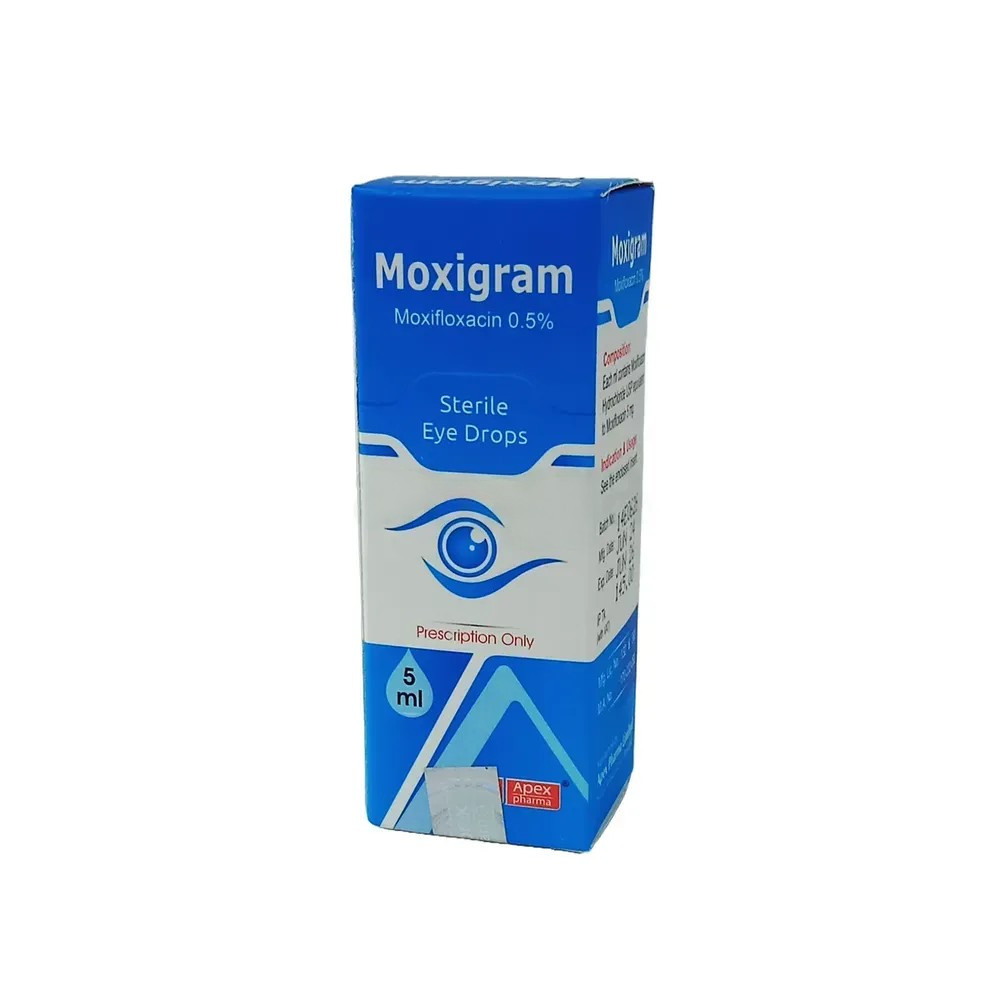5 ml drop:
৳ 145.00
Indications
Moxigram ophthalmic solution is indicated for the treatment of bacterial conjunctivitis caused by susceptible strains of the following organisms:
- Aerobic Gram-positive microorganisms: Corynebacterium species, Micrococcus luteus, Staphylococcus aureus, Staphylococcus epidermidis, Staphylococcus haemolyticus, Staphylococcus hominis, Staphylococcus warneri, Streptococcus pneumoniae, Streptococcus viridans group.
- Aerobic Gram-negative microorganisms: Acinetobacterlwoffii, Haemophilusinfluenzae, Haemophilus parainfluenzae.
- Other microorganisms: Chlamydia trachomatis.
Pharmacology
The antimicrobial action of Moxifloxacin results from inhibition of the topoisomerase II (DNA gyrase) and topoisomerase IV. DNA gyrase is an essential enzyme that is involved in the replication, transcription and repair of bacterial DNA. Topoisomerase IV is an enzyme known to play a key role in the partitioning of the chromosomal DNA during bacterial cell division.
Dosage & Administration
Eye Drops: One drop in the affected eye 3 times per day for 7 days.
Eye Ointment: It should be applied thinly and evenly to the affected eye three times a day for the first two days and for the next five days apply two times a day or as advised by the registered physician.
Intraocular injection: Intraocular Moxifloxacin can be administered as 0.2-0.4 ml dose prior to ocular surgery via intraocular route. The final dose must be determined by the doctor.
Eye Ointment: It should be applied thinly and evenly to the affected eye three times a day for the first two days and for the next five days apply two times a day or as advised by the registered physician.
Intraocular injection: Intraocular Moxifloxacin can be administered as 0.2-0.4 ml dose prior to ocular surgery via intraocular route. The final dose must be determined by the doctor.
Interaction
Drug-drug interaction studies have not been conducted with Moxigram ophthalmic solution. In vitro studies indicate that Moxigram does not inhibit CYP3A4, CYP2D6, CYP2C9, CYP2C19, or CYP1A2 indicating that Moxigram is unlikely to alter the pharmacokinetics of drugs metabolized by these cytochrome P450 isozymes.
Contraindications
Moxifloxacin Hydrochloride ophthalmic solution is contraindicated in patients with a history of hypersensitivity to Moxifloxacin, to other quinolones, or to any of the components in this medication.
Side Effects
The most frequently reported ocular adverse events were conjunctivitis, decreased visual acuity, dry eye, keratitis, ocular discomfort, ocular hyperemia, ocular pain, ocular pruritus, subconjunctival hemorrhage, and tearing. These events occurred in approximately 1-6% of patients. Nonocular adverse events reported at a rate of 1-4% were fever, increased cough, infection, otitis media, pharyngitis, rash, and rhinitis.
Pregnancy & Lactation
Since there are no adequate and well-controlled studies in pregnant women, Moxifloxacin Hydrochloride ophthalmic solution should be used during pregnancy only if the potential benefit justifies the potential risk to the fetus. Moxifloxacin has not been measured in human milk, although it can be presumed to be excreted in human milk. Caution should be exercised when Moxifloxacin hydrochloride ophthalmic solution is administered to a nursing mother.
Precautions & Warnings
As with other anti-infectives, prolonged use may result in overgrowth of nonsusceptible organisms, including fungi. If superinfection occurs, discontinue use and institute alternative therapy. Whenever clinical judgment dictates, the patient should be examined with the aid of magnification, such as slit lamp biomicroscopy, and, where appropriate, fluorescein staining. Patients should be advised not to wear contact lenses if they have signs and symptoms of bacterial conjunctivitis.
Therapeutic Class
Ophthalmic antibacterial drugs
Storage Conditions
Store bellow 25°C. Do not freeze. Store in cool and dry place, protected from light. Keep out of the reach of children. Do not touch dropper tip to any surface as this may contaminate Moxigram. Do not use after one month of first opening.


